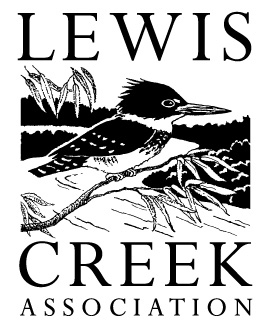Among the Great Egrets and Northern Map Turtles in Charlotte’s Town Farm Bay and Shelburne’s LaPlatte River wetlands, volunteers removed non-native aquatic invasive European frogbit for the fifteenth consecutive year this summer. Lewis Creek Association’s (LCA) “Water Quality Stewardship Program” is an invasive plant and water quality project coordinated annually since 2007. It is supported by LCA, the towns of Charlotte, Shelburne, and Hinesburg, Point Bay Marina, Shelburne Bay Boat Club and a Charlotte property owner.
European frogbit was introduced to arboretum ponds in Ottawa in 1932 before spreading to the United States via the St. Lawrence River. It is considered an aquatic invasive species (AIS) because it grows on the water surface and out-competes native plants for sunlight and nutrients. In 2007, friends of LCA discovered frogbit covering 50% of Town Farm Bay. Through volunteers’ annual field work, the frogbit cover has been substantially reduced and is now maintained at about 5% cover. In contrast, when frogbit was discovered in the wetlands of the LaPlatte Natural Area, it had low percent coverage, providing an opportunity for “early detection, rapid response.” Though the invasive plant will never be eradicated in either location, maintaining this low population allows native plants and animals to thrive. This year, volunteers removed 459 pounds of frogbit from Town Farm Bay and 1.5 pounds of frogbit from the LaPlatte River wetlands (where frogbit levels were very low at the beginning of this season, and remained low throughout the season).
Volunteers remove European frogbit plants in Town Farm Bay. Photo credit: Matt Gorton
LCA’s Water Quality Stewardship Program also includes the annual monitoring of water quality in the LaPlatte River, Patrick Brook, McCabe’s Brook, Thorp Brook, and Kimball Brook by volunteers for South Chittenden River Watch. Volunteers collect water samples which are then analyzed by the Vermont Agricultural and Environmental Laboratory, and interpreted by LCA technical consultants. The sampling season has recently wrapped up, and included sampling for nutrients and chloride, in order to understand sources of nutrient loading to Lake Champlain while informing water quality improvement project plans. 2021 results will be available on our website in the spring of 2022; to see past years’ results, visit the LCA website at lewiscreek.org. Check out more information on water quality and what you can do to improve it on LCA’s YouTube channel at https://bit.ly/3iS2z4b.
This water quality stewardship program is important for maintaining productive, functioning, and scenic waters, and also allows residents of Charlotte and Shelburne to become advocates for water quality. Volunteers in each town help share this information with neighbors and friends, helping improve water quality in the future. This program being funded through your Town budget is crucial, since it allows the whole community to take ownership of local water quality and natural resources that are extremely important to protect. This will result in healthier ecosystems that all citizens can enjoy. If you are interested in assisting with water quality monitoring or invasive plant removal in 2022, please reach out to Kate Kelly, LCA Program Manager, at lewiscreekorg@gmail.com or 488-5203.

